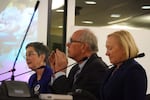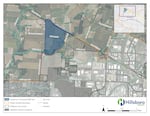Competing visions over the future of rural land near Hillsboro drew over a hundred people to a packed hearing room Thursday night.
Elected officials, industry leaders and some residents made their case to expand Hillsboro’s urban growth boundary to make way for a major semiconductor research center. Other residents, joined by farmers and environmental and land conservation groups, largely criticized what they say is an unnecessary land grab.
At the heart of the dispute is also Oregon’s 51-year-old system of state land use laws, which serve as a guiding star to prevent over-development on land outside metro areas.

Local residents, farmers and environmental and land and conservation groups rallied outside the Hillsboro Civic Center in opposition of Gov. Tina Kotek's proposal to bring rural land into the city's urban growth boundary, Oct. 10, 2024.
Alejandro Figueroa / OPB
Last month, Gov. Tina Kotek announced her intentions to bring 373 acres of rural land north of Hillsboro into its urban growth boundary through a temporary and controversial authority lawmakers granted her during the 2023 state legislative session.
Oregon government and industry leaders hope to land a federal research hub designation, the National Semiconductor Technology Center, which politicians say would bolster the state as a leader in semiconductor manufacturing and bring jobs for future generations of Oregonians. – They see a Hillsboro growth boundary expansion as a tool to recruit that research hub, which would be funded by the federal CHIPS and Science Act of 2022.
Other states such as California and New York are also competing for the federal designation.
“We know other proposals are offering attractive packages, including ample land to develop an NSTC [National Semiconductor Technology Center] site that can expand over time,” said Vince Porter, Gov. Kotek’s deputy chief of staff for public administration. “We must ensure Oregon’s competitiveness in attracting those opportunities.”
Officials say Hillsboro, where there’s a large concentration of semiconductor businesses – including the Intel campus, is the perfect location for the research center. And the 373 acres – directly south of U.S. 26 – are ideal, because it’s in close proximity to other semiconductor manufacturing and supply chain businesses.

Elected officials, including Washington County Commission Chair Kathryn Harrington (left) and Hillsboro Mayor Steve Callaway (center) speaking in favor of expanding the Hillsboro urban growth boundary to make way for semiconductor development, Oct. 10, 2024.
Alejandro Figueroa / OPB
“Oregon and Hillsboro have long benefited from the economic opportunities and to a certain degree, stability that this industry has brought,” Dan Dias, Hillsboro’s economic development director, told OPB. “And for those reasons we are approaching this and thinking about this as both a near term and long term need and opportunity.”
Oregon has long played a role in the national semiconductor workforce. The industry employs around 33,000 people in the state, representing nearly 15% of the industry’s national workforce.
But farmers and land and environmental groups say there is plenty of unused industrial land elsewhere in and outside Hillsboro, and that the governor has not made a case for needing to bring an additional 373 acres into the city’s urban growth boundary for the federal research hub. They’ve also argued Hillsboro city developers have squandered its industrial land by permitting data centers that take up large amounts of land and employ few people.

A map of the area Oregon Gov. Tina Kotek has proposed adding to the Hillsboro urban growth boundary, as part of an effort to recruit a semiconductor hub to the site.
Courtesy city of Hillsboro
“We’ve had no evidence that the success of this application [to become a research hub] is dependent upon these 373 acres. If that evidence is out there, bring it forward and let’s talk about it,” said Nellie McAdams, the executive director at the Oregon Agricultural Trust. “This process is designed to exclude any real informed decision making and decision making that involves the public and the people who are going to be most affected.”
Oregon’s land protection laws are enshrined in Senate Bill 100, which passed in 1973. It guides the state’s planning system and protects farms and forests from urban sprawl. Usually, expanding urban boundaries into rural farmland is a lengthy process that involves input from the public.
Related: Oregon’s unique growth rules have preserved open space but also led to new fights
But 2023 Senate Bill 4 gave the governor the authority to bypass that process, if she determines that adequate land doesn’t exist for semiconductor manufacturing development. That authority expires at the end of 2024.
Aaron Nichols, a Hillsboro farmer and organizer of Friends of Smart Growth, said there’s a reason why the state’s land-use system exists and why some of his neighbors and peers are so passionate about protecting that land.
The Willamette Valley has some of the most productive soils in the country, which can grow all sorts of vegetables and fruit, and once it’s paved over, it’s gone, said Nichols.
“The amount of prime farmland we have is very limited and disappearing at a rapid, rapid pace,” he said. “We know if we don’t protect farmland, in particular if we don’t protect enough of it to create a farming ecosystem we’re going to lose it, we’re going to lose the infrastructure that supports farming.”

Local residents and land conservation groups holding signs in opposition of expanding Hillsboro's urban growth boundary outside the Hillsboro Civic Center on Oct. 10, 2024.
Alejandro Figueroa / OPB
Oregon has indeed lost farms and farmland. From 2017 to 2022, Oregon lost 4% of its farmland – about 660,000 acres, according to the latest USDA census of agriculture. The state is the second highest among Western states with the most loss in farmland behind Washington.
Not all residents and landowners oppose the urban growth boundary expansion. At the hearing, some residents said the area Kotek proposes to bring into the growth boundary no longer feels rural or is conducive to working farms.
Related: Oregonians once feared their state would be wrecked by out-of-control sprawling development
Cindy Hodges, who owns lands within the proposed 373 acres, said she and her neighbors fully support the governor’s decision.
“While we appreciate opposing viewpoints, this is a historic moment that requires us to think big. Our opponents do not support urbanization of any land outside the UGB [urban growth boundary] regardless of the larger benefits or supporting data that it is best used for other purposes,” she said. “We know of no owners within the area identified that are opposed to redesignation.”
Kotek’s office is required to accept written public comments until Oct. 30. After that, she can decide whether to move forward with bringing the land into Hillsboro’s growth boundary or include even more land.
In September, the Oregonian/OregonLive reported Intel and U.S. Sen. Ron Wyden had been urging Kotek to expand the growth boundary by up to 1,700 acres to make the state as competitive as possible.
Opponents, including 1000 Friends of Oregon – a land conservation group – have said they will appeal the governor’s decision if she decides to move forward.
